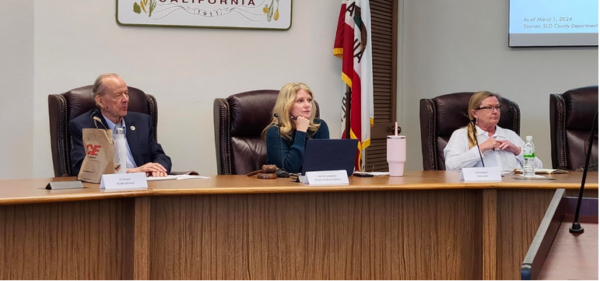Is Pismo Beach’s reclaimed water project doomed?
March 19, 2024

By KAREN VELIE
After expending millions of dollars and thousands of hours of time, representatives of Pismo Beach, Arroyo Grande and Grover Beach on Monday all but pulled the plug on Central Coast Blue, a regional recycled water project.
In response to years of drought, the cities of Pismo Beach, Arroyo Grande and Grover Beach agreed on plans for a recycled water project to bring an additional 900 to 1,000 acre feet of water annually to the South County cities, even during droughts. Another benefit would be the injection of recycled water into the basin, which could help protect against seawater intrusion.
However, delays and planning issues resulted in the cost of the project skyrocketing from an estimated $29 million to a current estimate of between $135 million to $158 million. Rising costs, an abundant water supply, the state reversing promises of grant funding and a Grover Beach citizens initiative against funding the project have led some government officials and members of the public to seek the projects elimination and the closure of the authority.
The three members of Central Coast Blue Regional Recycled Water Authority Board of Directors – Pismo Beach Mayor Ed Waage, Grover Beach Mayor Karen Bright and Arroyo Grande Council Member Kristen Barneich – met on Monday to discuss the future of the joint powers authority and the reclaimed water project.
In January, the State Water Resources Control Board informed Central Coast Blue that a $15 million grant awarded in Sept. 2023 would be reduced to $5 million, as the state grapples with a $68 billion budget deficit. In addition, staff anticipates cuts to 10 other grant awards, according to the staff report.
“This reduction is part of a statewide effort to address the $68 billion state budget deficit and is not unique to Central Coast Blue,” according to the staff report.
Staff previously anticipated the bulk of the cost of the project would be funded through state grants.
Last week, a citizens group in Grover Beach turned in more than four times the required signatures to put an initiative to repeal a 112% water rate increase on the November ballot. The bulk of the water rate increase was slated to help fund Central Coast Blue.
In addition, water supply conditions have greatly improved since the historic drought of 2019 through 2022. Lopez Lake has enough water to fulfill its South County water obligations for four to six years, without another drop of rain falling, staff said during the meeting.
“In consideration of the recent improvements to water supply conditions, loss of grant funding, and increased project costs, the project team has recommended a series of near-term actions,” according to the staff report. “These actions consist of a water supply strategy evaluation by each of the partner agencies along with project management efforts that include pursuit of additional funding, a temporary pause to detailed design and permitting, re-evaluation of the project implementation schedule, and analysis of value engineering and collaborative delivery options to reduce project cost.”
Multiple public speakers asked the board to dump the recycled water project and shutter the agency.
Instead of shuttering Central Coast Blue, the agency is withdrawing its permit requests to the California Coastal Commission and Grover Beach, where the project was to be located, and pausing the project for a year. During that time, staff recommends the board approve the hiring of an outside consultant to provide community engagement.
In addition, Central Coast Blue General Manager Geoff English plans to head to Sacramento to find additional revenue sources.






The comments below represent the opinion of the writer and do not represent the views or policies of CalCoastNews.com. Please address the Policies, events and arguments, not the person. Constructive debate is good; mockery, taunting, and name calling is not. Comment Guidelines